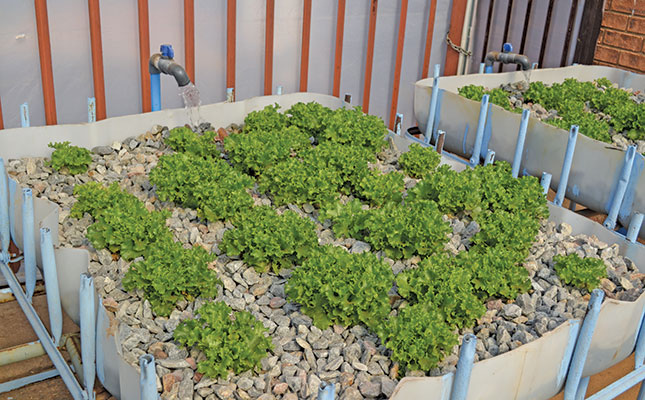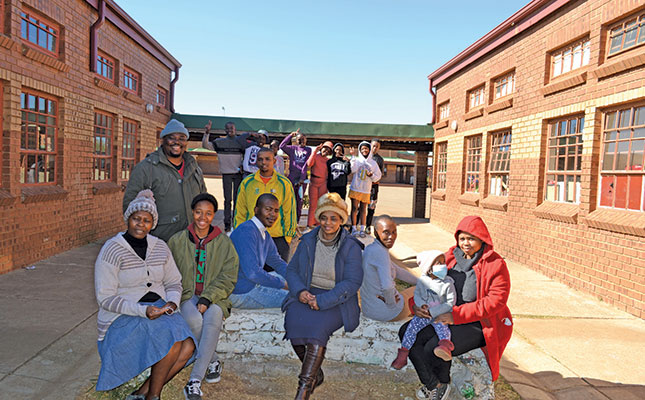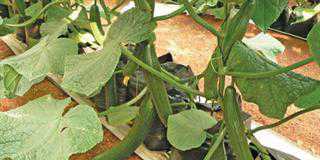
Technology and innovation need not be the exclusive domain of mega farmers and multinational organisations. With the right help, even a township school can lead the way.
This is well illustrated by the story of Lesedi la Kreste Anglican Primary, a state-owned school in Orange Farm, a township approximately 45km south of Johannesburg alongside the N1 and R553 highways.
For over a decade, this school’s 1 427 learners have had the opportunity to join the school’s environmental club, where they are taught the basics of recycling, aquaponics and agriculture. The school also has a functioning aquaponics system where a variety of vegetables are grown in gravel with the help of catfish.
Simply put, aquaponics relies on a natural cycle where the waste from the fish serves as fertiliser for the plants, while the plants filter the water, keeping it clean for the fish. The system is entirely closed: in other words, the water is recirculated through the system, and no chemicals are used.
Although aquaponics has become a buzzword amongst backyard farming enthusiasts in recent years, it was not quite as well known in South Africa back in 2011 when it was introduced at the school. In fact, this was one of the first aquaponics systems installed in the country by INMED South Africa.
INMED Partnerships for Children is an international non-profit organisation dedicated to helping vulnerable children, families and communities “achieve well-being and self-reliance”.
And its Aquaponics Social Enterprise programme aims to mitigate poverty and malnutrition by helping “subsistence producers and their communities adapt to climate change, while conserving natural resources and increasing access to economic and technical assets”.
INMED retained its interest in the school after donating the aquaponics system. A decade later, the company upgraded and expanded the equipment as part of its Health in Action programme in partnership with the Mondelez International Foundation.
While these are all noble objectives, one cannot help but wonder why a school should be involved in aquaponics.
“It’s efficient, it saves water and it’s fun for the kids to learn,” says Pinkie Motlanyane, the teacher who serves as the central coordinator for the environmental club.
“It also combines different things into one farming system, because children get to farm both fish and vegetables. Our children’s knowledge must be expanded and they need to be able to see that there’s a bigger picture. Aquaponics makes it easier for a child to grasp this.”
The school currently has 28 catfish in its aquaponics system and grows about 150 plants in a cycle (four to six weeks). The produce is given to the children in the environmental club and also to particularly disadvantaged children, who can take it home to their families.
Spinach and beetroot were being grown during Farmer’s Weekly’s visit to the farm (in midwinter), and cabbage and lettuce have also been produced in the past.
Motlanyane is keen to expand the operation. “Aquaponics provides a platform that allows learners to explore, imagine and discover,” she says. “Not only do they learn more about natural sciences, but their creativity is expanded in the process.”
A group of young volunteers from the non-profit organisation Xhumanisa has also been helping the school with the maintenance of the aquaponics project during the week.
In fact, the entire project began when the group approached the school.
“The project started with a conventional fruit and vegetable garden on the school’s premises,” says Esaka Leuka Mantso, a Xhumanisa representative. Only later did INMED’s assistance enable them to start the aquaponics project.
“Xhumanisa means ‘connection’ in Xhosa and that’s what we aim to do. We want to connect children with agriculture.”
Every Wednesday and Thursday afternoon the learners take part in their chosen sport or extramural activity. Currently, 43 children in the senior phase (grades 4 to 7) and 27 children in the foundation phase (grades 1 to 3) are in the environmental club.
“The children love this group more than sport,” says Motlanyane.
In fact, the number of children participating in the programme had to be limited, as not enough adult supervision was available, and teaching is very much part of the experience.
“We teach the children to look after the garden beds, recycle and clean up the terrain,” she says.
The school and Xhumanisa have a direct, practical impact on the community. They often take the lead, for example, in organising clean-up campaigns.
“We monitor the terrain around the school,” says Mantso. “If it becomes too dirty and our programme allows, we have a practical outreach where we clean the streets. Big clean-up events take place once or twice per year, depending on the community’s needs.”
This activity teaches the children the value of cleaning and recycling. Unfortunately, COVID-19 protocols temporarily hampered the group and they were unable to clean up as much as they would have liked.
One of the practical ways in which children have been taught to recycle is through the building of eco bricks. Three benches have already been built from eco bricks made by the children.
An eco brick is a two-litre plastic cold drink bottle filled with plastic waste, such as plastic
bags, until it reaches a weight of 1,2kg. The more densely the bottle’s contents are compacted, the more durable and less flammable the eco brick will be.
Conserving nature is a top priority for the group, stresses Mantso. The children have also been taught the importance of trees, and the group has planted a number of trees on the terrain. At special events, such as Arbour Day, the group holds a special tree-planting ceremony.
The farming programme is not merely a group for ecological enthusiasts; it is a practical extension of classroom lessons.
“What can be more perfect than taking a grade-one pupil to the garden to see how a plant grows after they’ve just learnt the theory in a classroom?” asks Motlanyane.
“We also discuss environmental issues within a subject-specific setting.”
These activities, unfortunately, are not taking place as often as she would like due to staffing shortages; the school lost several teachers during the COVID-19 pandemic and they have still not been replaced.
“Prior to COVID-19, the science teachers were much more involved in the project. They’re still part of it, but not as much as they were previously, due to the other demands of their jobs.”
More funding needed
According to Mantso, funding and the pandemic have been the two biggest obstacles faced by the project. Although he is extremely grateful for the help already received, there is a need for even more.
“If we could obtain [increased] funding, we might be able to pay a stipend to volunteers and perhaps even find more people willing to help with the project. Unfortunately, it’s not sustainable to work for free.
“We really want to involve more young people in the project, because it’s a wonderful learning experience. But this isn’t possible without funding. We need funding for just about every part of the project, from tools to resources to research. Everybody currently works on a voluntary basis.”
He adds that the volunteers are aged between 21 and 49, with the majority being under 35.

The ultimate goal of the project leaders is to create an environment where school leavers would be empowered to learn practical skills and thereby secure a better future.
“When I look at the state of the country, I see a lot of problems such as alcohol abuse
and a high teen pregnancy rate. If our project can gain greater momentum, we might be able to help curb this trend,” says Mantso, adding that youngsters could be taught more than just aquaponics.
“We could teach people to become welders, farmers and carpenters, to name but a few. Unfortunately, it seems that big, national projects get all the funding.”
It was precisely for this reason that the Xhumanisa group registered itself as a non-profit organisation in 2019, but it has since been held back by the economic realities of the COVID-19 pandemic.
“We’ve been sending out several proposals to large organisations, but we’re still in search of [such] funding to let this dream become a reality. There’s a tax benefit for donors too.”
Asked whether the produce from the garden could not be sold to pay workers, Mantso was adamant that this would defeat the purpose of the project.
“Whenever we have vegetables that are ready for harvest, it’s given to the children.”
Email Pinkie Motlanyane at [email protected].










